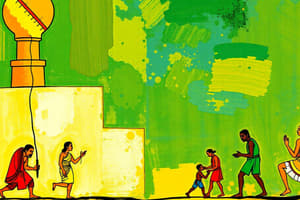Podcast
Questions and Answers
Kautilya was also known as?
Kautilya was also known as?
- Swami Vivekananda
- Chanakya (correct)
- Dayanand Saraswati
- Saraswati
Kautilya’s Arthasastra consists of?
Kautilya’s Arthasastra consists of?
- 10 Books
- 15 Books (correct)
- 22 Books
- 20 Books
The main architect of ancient Indian polity was?
The main architect of ancient Indian polity was?
- Kautilya (correct)
- Rammohan Roy
- Jawaharlal Nehru
- B.R. Ambedkar
What constitutes the most reliable and original source of Indian political thought?
What constitutes the most reliable and original source of Indian political thought?
Which of the following is not a source of Indian political thought?
Which of the following is not a source of Indian political thought?
In Arthasastra, Kautilya divided the State into?
In Arthasastra, Kautilya divided the State into?
In Arthasastra, the king?
In Arthasastra, the king?
Which of the following is not Kautilya’s element of state?
Which of the following is not Kautilya’s element of state?
Kautilya suggests that the Council of Ministers should consist of?
Kautilya suggests that the Council of Ministers should consist of?
Kautilya prescribes for members acquainted with sacred law?
Kautilya prescribes for members acquainted with sacred law?
In Arthasastra, which of the following is not included in the major types of punishment?
In Arthasastra, which of the following is not included in the major types of punishment?
In the field of foreign policy, Kautilya suggested that there should be policy of the state?
In the field of foreign policy, Kautilya suggested that there should be policy of the state?
In Vedic literature, there are?
In Vedic literature, there are?
In Arthasastra, secret war was carried out from?
In Arthasastra, secret war was carried out from?
In Arthasastra, Kautilya mentioned about?
In Arthasastra, Kautilya mentioned about?
Arthasastra was written in?
Arthasastra was written in?
Kautilya was the ____________ of Chandragupta Maurya?
Kautilya was the ____________ of Chandragupta Maurya?
Whose statement is this: 'In the happiness of his subjects lies the king's happiness, in their welfare lies his welfare.'?
Whose statement is this: 'In the happiness of his subjects lies the king's happiness, in their welfare lies his welfare.'?
Who says 'A king who administers justice in accordance with Dharma, Evidence, Customs and Written Laws will be able to conquer the whole world'?
Who says 'A king who administers justice in accordance with Dharma, Evidence, Customs and Written Laws will be able to conquer the whole world'?
According to Kautilya, if there is conflict among the various laws, which one of the following law is supreme?
According to Kautilya, if there is conflict among the various laws, which one of the following law is supreme?
Kautilya belongs to the caste of?
Kautilya belongs to the caste of?
Kautilya categorizes legal matters into?
Kautilya categorizes legal matters into?
Who was the founder of Brahmo Samaj?
Who was the founder of Brahmo Samaj?
Who is known as the Father of Modern India?
Who is known as the Father of Modern India?
Brahmo Samaj opposed?
Brahmo Samaj opposed?
Which of the following social reformers propagated the concept of universal religion?
Which of the following social reformers propagated the concept of universal religion?
Who wrote the book 'A Gift to Monotheists'?
Who wrote the book 'A Gift to Monotheists'?
Which of the following reform movements was the first to be started in the 19th century?
Which of the following reform movements was the first to be started in the 19th century?
Which of the following statements with regard to Raja Ram Mohan Roy is/are correct?
Which of the following statements with regard to Raja Ram Mohan Roy is/are correct?
Who is called the pioneer of Indian Renaissance in 19th A.D.?
Who is called the pioneer of Indian Renaissance in 19th A.D.?
Flashcards are hidden until you start studying
Study Notes
Kautilya and Arthashastra
- Kautilya, also known as Chanakya, was the main architect of ancient Indian polity.
- His work, Arthashastra, is a treatise on statecraft, economics, and military strategy.
- Arthashastra consists of 15 books and is considered the most reliable and original source of Indian political thought.
- Kautilya divided the state into 7 elements:
- King (Raja)
- Council of Ministers (Amatya)
- Treasury (Kosha)
- Army (Danda)
- Territory (Janapada)
- Allies (Mitra)
- Enemies (Ari)
- The king is the law-maker and protector, but not the sole law-passer.
- The Council of Ministers should consist of 7 or 8 ministers, with 3 or 4 members acquainted with sacred law.
- Kautilya emphasizes the importance of spies and identifies 10 different types.
- In foreign policy, Kautilya advocated for a six-fold policy, including making peace, war, neutrality, alliance, and others.
Vedic Literature
- Vedic literature consists of 4 Vedas: Rig Veda, Sama Veda, Yajur Veda, and Atharva Veda.
Social Reformers
- Raja Ram Mohan Roy founded the Brahmo Samaj in 1828.
- Brahmo Samaj opposed the sati system, caste system, and child marriage.
- Raja Ram Mohan Roy is considered the Father of Modern India.
- He advocated for the promotion of English language, universal religion, and believed in the monotheism of the Vedas and unitarianism of Christianity.
- He wrote the book "A Gift to Monotheists."
Studying That Suits You
Use AI to generate personalized quizzes and flashcards to suit your learning preferences.



